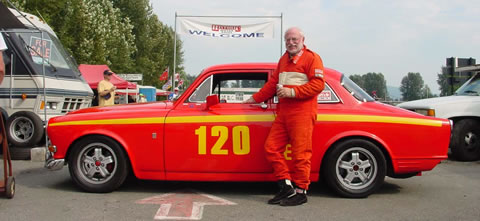
Meeting Jim Latham and Greta Does the Dyno
From our September 2008 Newsletter
You will probably recognize Jim Latham and his 122S race car named Greta. Both have featured in our newsletter a few times before. It has been educational to see the steady improvement Jim has made to the car's performance.
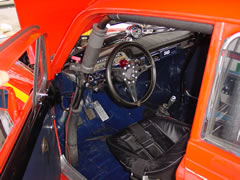
Jim has been racing on and off since 1971. As a young teacher in Trail, BC, he bought a 1965 Mini Cooper S, with a 1071cc engine. The car was in what we would call today “Street Performance Tune”, and it had a roll bar. Jim’s a logical guy, and he deduced that if the car has a roll bar it must be a race car, so it only made sense to go racing. He raced at tracks in Spokane, Seattle and at Vancouver’s Westwood as well as the odd unofficial hill-climb event in Trail. There is definitely no shortage of hills around Trail.
In 1974 Jim moved to Vancouver with a growing family and growing responsibilities. The race car had to go. He did get one more opportunity on the track before he went into racing hibernation. A friend of Jim’s bought an Alfa Guilia Sprint Veloce, with the intention of going racing (the former Procter car). The only flaw was the owner didn’t have a race licence, so Jim made the great sacrifice and volunteered to drive the car for him at Westwood. He even managed to turn a 1 minute 25 second lap, which was an impressive time for the car and the driver.
Shortly before the Driver’s Training he found the engine and damaged frame of a 1977 Tiga Formula Ford at Blair Gehman’s (The Chassis Tuners) shop in Chilliwack. At Driver’s Training Felim Power had a booth to advertise the Club Ford series he was organizing. In chatting with Felim, Jim mentioned he knew of the Tiga; coincidentally Felim knew the whereabouts of the rest of that car, stored near Forest Grove in central BC. It was a car with a very storied past. Notable previous owners were Bob MacGregor, Ross Bentley and Rick Payne. After several calls Jim tracked it down and bought the whole works for $3000. All the car needed was everything; an absolutely total, from scratch, restoration. And that is just what it got. Other than the engine rebuild by Graeme Hutton, re-fabricating the damaged chassis and front bulkhead by Ken Dye, and the bodywork repair and eventual carbon fibre shell by Glen Freeman, Jim personally built or rebuilt everything else in the car. He raced the car for 3 years in the late ‘90s until he felt that his reaction times were no longer fast enough to safely race the Formula Ford and he sold the car to Jack Teague from Kent WA.
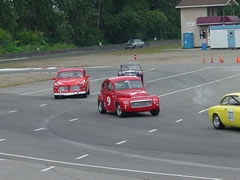
His current racer is the 68 Volvo 122S “Greta” that we are familiar with. I asked Jim why he chose a Volvo to race and whether he had owned Volvos before. Here is his answer.
“My family did not own a car until I was in grade 11. By then I was attending races at Westwood with my uncle and other friends - like Dick Barwell, whose Alfa I raced for him before he had his licence. Anyhow, my Dad said to me "What should we buy?" thinking that with all of us growing up and doing all sorts of things, a car was needed. He rode a bike. I said if we can find a good Volvo let's go for it. We did, a 1959 white 544 B16 which we kept for a year. Dad then said he wanted to get a new car and was now already convinced it should be a new Volvo. So in 1962 he and I and my twin brothers made the trek to Docksteaders (Burrard and Georgia) where we picked out a 1962 2 door Canadian 4 speed in that grey/blue with the light grey leatherette interior. It cost exactly $3095 (with the seatbelts). We all drove it. - All 6 of us, and my siblings all learned to drive on it. It was hit twice, rolled once and finally after many years and one transmission, and two clutches, with the head never off, it was T-boned in Vancouver with one of my brothers driving at about 405,000 miles. It was still rust free. I loved rat racing that car around the Chilliwack area. Since I found that the back seat also could be the site of much pleasure in this car with a particularly athletic girlfriend, it seemed like the perfect car for nearly anything. So then when I found Greta, it just seemed like the chance to do the one thing that I always wanted to do with that car back in 1962 that I had not done - make it fast. Needless to say my siblings love the fact it is a Volvo. So no, to answer the question, I never owned a Volvo, till Greta. But I think we are genetically linked.”
Jim’s 122S race car has had an interesting history. The car was converted to a rally car by an Edmonton Volvo racer, sometime during the early ‘70s and competed in rallies, slaloms, hill climbs and road courses. I remember it turning up in the car park at the Westwood Historic Race Days in the early ‘80s, wearing its same distinctive paint scheme of bright reddish orange and a bright yellow side stripe. Even then it displayed many dash plaques from races in the 70s. It came up for sale in the Buy and Sell in the late ‘80s and was purchased by Mike Handfield who subsequently sold it to Nick Seldon of Allvo. After Nick, the car changed hands twice until it was purchased by Vintage Racer, Leigh Anderson. Leigh discovered that the car had suffered the ravages of too many races and hard rallies, interspersed with too much time on the street and it was literally coming apart at the seams. It needed some structural work and Leigh’s son welded up all the seams in the car and cut out the rust and generally stiffened it up. With the body sound, Leigh steadily improved the power train and handling during his years of ownership. He had a 4.56 P1800 axle and True Track differential installed by IWE and had 40 DCOE Webers (which SOVREN would disallow).
Jim Latham bought the car in the spring of 2005. From Leigh he received some of the car’s history and has continued to research it. For one thing he learned that the car was named Greta in 1970, after the Swedish redhead Greta Garbo. Jim’s first opportunity to race Greta came in the fall of 2005 and with that brief track time he formulated a plan for improving the car's performance and appearance. That winter Greta went on a diet. He had her stripped down and repainted in its original colours by Paramount Auto Body. Jim replaced all of the side glass with Lexan, the front and rear glass with Margard, removed all the interior sound deadening and undercoating, removed the head liner, overdrive unit, replaced the door panels with corrugated plastic sign board, and numerous other details that added up to a 167 lb. weight reduction. His goal has always been to prepare the car to SCCA 1969 GCR status so that it will in vintage events as a 1969 SCCA B sedan which will be group 2 for SOVREN. During 2006 Jim improved the suspension, adding tow out, reducing bump steer, changing shocks, wheels and tires. At the end of the 2006 season he installed a preliminary version of his new engine and a fuel cell. The engine was built by Fred Key of Key Imports in Abbotsford. The first iteration had an upgraded bottom end but had an interim head. The finished engine would not be seen until the first race of 2008 and it was impressive.
Greta Does the Dyno
On the strength of the engines performance at the April 2008 race, Jim arranged for some time on a load cell equipped dynamometer. Dave McAree and I were invited to attend the dyno-test session and it was hugely entertaining for us and proved to be an extremely valuable tuning tool for Jim. Here is how the day went.
Jim lives in Abbottsford in the eastern end of the Vancouver Lower Mainland and he had arranged for his test at Miller Performance Cars, a BMW performance specialist in Abbotsford. I left from my home in Port Moody, early, not knowing how the eastbound traffic would be on the freeway and arrived at Miller Performance about half an hour early. There were a variety of BMWs outside the large and modern shop and the shop is located right behind the Abbotsford Greyhound bus depot, so there was a lot to look at while I waited. After a while a young fellow on an old bike with monkey bars and a banana seat rode through the bus depot and tooled around the parking lot for a while and eventually made his way to the back door of the Miller shop. Not long after that there was a tremendous bang from somewhere. If we were in Iraq everyone would have hit the ground. Thirty seconds later another ferocious kabang!! And Jim Latham and race car arrive on the scene. In fact they were the “scene”.
All was not well with the race car and it was showing its disapproval by backfiring and shooting neat flames out the side mounted exhaust pipe. Of course the car had run perfectly the day before and chose dyno-day to throw a fit. We opened the hood and stared at the engine with great intelligence. It looked just fine from the outside, other than bits of irreplaceable choke linkage that had fallen off the SU carburettors between Jim’s house and the shop. It was not looking promising for dyno day.
I should have had more faith. Fred Key, the builder of Jim’s race engine has his shop nearby, and he was already on his way over to observe the dyno test. When Fred arrived and heard Jim’s story, he didn’t seem too concerned so Jim fired up the car and popped and banged his way towards the dyno. The young fellow who had been riding his bike around the parking lot, and who I had assumed was a shop helper, introduced himself as Brody Saari, vice president of Wilson Performance Cars and dyno operator. I should have known.
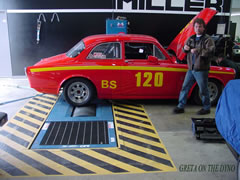
Brody and his helper strapped the rear wheels of the grouchy race car onto their brand spanking new single roller dyno. After a little instruction for Jim the driver, they did one test run with Fred looking on. The car outdid itself. The explosion and resulting flame from the exhaust was even more impressive inside a building than it was on the road and Fred called a halt to the performance and looked for some tools. He pulled the spark plugs and they looked oily around the electrode and he calmly declared that the wetness was shorting out one or more of the plugs, causing the backfires. He installed a new set of plugs and all was well.
Now would be a good time for a lesson on dynamometers. Everyone who has taken their car through Air Care has had some experience with a dynamometer. They consist of a single or double roller supported in a concrete chamber such that the top of the roller is a bit higher than the surrounding floor. The drive wheels of the vehicle are positioned over the roller/s so that the rollers of the dyno are driven (rotated) by the wheels of the car. The dynamometers at Air Care stations are fitted with load cells. That is they have the ability to apply resistance to the driving wheels of the car being tested in order to simulate real driving conditions, while the engine emissions are tested. Not all dynamometers have load cells.
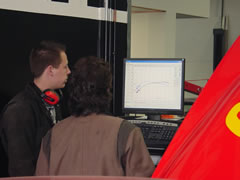
Let’s let dyno operator Brody Saari, describe his dynamometer and explain to us the benefit of having it equipped with a load cell.
“Our dyno at Miller Performance is a Mustang 1100SE capable of up to 1700HP and 225 MPH. You are right; it has an eddy brake load cell. This is beneficial because it not only simulates the real world conditions, such as weight of the car, wind resistance etc. etc., it helps tune a car much more accurately. Most inertia dynos (dynos with no load cell) do not put nearly enough resistance to the wheels. If you noticed it took about 8 - 10 seconds to do a pull with Jim’s car. On a dyno such as a Dynojet, with no load cell, the run would have ended much sooner. Think of how fast your car revs in neutral to the red line and compare it to how long it takes to get to the red line in fourth gear on the road. Do you see what I am saying?
Load cells have many functions, they can help trouble shoot a certain RPM, programming our machine to hold the engine constant... varying load to stay with in the set RPM or speed for certain types of tuning. You can do 0-60 times and 1/4mile times, something that cannot be done on inertia style dyno. Finally, the eddy brake load cell gives real world HP figures for the wheels. It's a more conservativee number than inertia dynos; any where from 30 - 40 HP difference. I would more strongly believe a number from an eddy brake (load cell) dyno than an inertia dyno. As a quick example, our R&D car puts 450HP and 460 Ft. lbs. of torque to the rear wheels with the load cell on. That is a far more accurate number to the 482 HP recorded with the load cell turned off.”
What Jim and Fred wanted to accomplish with the dyno session was to determine what horsepower and torque the engine was currently producing and then try two alternate needles in the SU Carburettors and then try a couple of alternate ignition timing settings. Ultimately they were trying to find the ultimate combination of torque, horsepower and air/fuel ratio for racing conditions. They succeeded, at least theoretically.
Before starting the tests Brody took some information about the car and entered into the dynamometer computer consol. He entered the make and model of the car, its weight, the number of cylinders in the engine and the maximum rpm the engine was designed for. Brody explained that the dyno software uses the cars weight and frontal area to determine the amount of resistance to be provided by the load cell. The load simulates a flat road with the car travelling at 50 mph. Finally he had Jim sign a waiver of shop liability in the event the engine blew up.
The way the tests were run Jim drove the car and Brody stood beside the dyno at the computer terminal. On Brody’s signal Jim shifted up through the gears until he was in 4th with a 1:1 ratio, keeping it under 3000 RPM. At that point Brody signalled Jim to floor the accelerator and leave it there until the run was over. The run is very dramatic. There is lots of noise, some smoke as the loaded engine races its way to redline. As a spectator your reaction it to get the heck out of the way and you involuntarily start gritting your teeth as the engine reaches redline and at the same time you have a big grin on your face. When red-line is reached Brody signals Jim to put the car in neutral and the dyno goes into “brake” mode and slows the wheels until they stop.
Once a run is completed everyone huddles around the computer monitor as Brody brings up a graph on the screen. On the Y axis is Horse Power, Torque, and air/fuel mixture and on the X axis is engine rpm. The three coloured lines on the graph show you how horsepower, torque and mixture vary with rpm during the test. On a table under the graph it lists the max, min and average values for each parameter.
For instance Jim’s initial set up produced a maximum of 138 hp and 137 ft-lb of torque at the rear wheels, and it also showed that the engine was a bit too rich up to 5500 and a bit too lean from there until the power fell off at 6500 rpm. The needles here were the UK needle he had last used at Mission which were strong but would not exceed 5500 RPM in top gear. The car was flat up there in fourth gear.
After the first run Jim and Fred took the tops off the SU Carbs, removed the pistons and inserted the second set of needles. Brody and his assistant were very interested to watch Fred work on these carburettors, that were designed not long after the horse and buggy days and long before these youngsters were born. These young fellows are wizards with fuel injection, turbo chargers and programmable engine management systems; carburettors are a novelty to them. They marvelled at how efficient they actually were!
Now ready for the second run, the new needle (UJ) was supposed to be leaner throughout the range, but it did not react the way the needle chart said it should. It produced a big dip in power and torque at about 3500 rpm, was too rich all the way through the rev range, although the max power and torque were a bit higher than the first run. Fred also realized that the electronic retard for low PRM was affecting things so he unplugged that component. So much for those needles.
It was the third set of needles that Jim had his hopes on. He had researched his exact model of SU carb and its application on big Healy’s and had concluded that a “rich Healy” needle may be the route to go (the UN) He was right, at least on the dyno. The maximum power was up to 137 HP and torque was up to 147 ft-lb, and the mixture was just on the rich (safe) side of optimum. The torque increased steadily, peaking at about 4000 rpm and staying reasonably constant almost to redline. He had found the right needle and now began the timing tests.
On the final two runs they modified the distributor total advance which was initially set to 38 degrees before top dead centre (btdc). First they retarded it by 4 degrees and max horsepower and torque were both down and they really fell fast at 6500 rpm. Advancing the timing 3 degrees to a total advance of 41 degrees btdc reduced the max torque by one point to 142 ft lb, but increased the max horsepower to 143 HP and both stayed up better right to 6500 rpm. The whole run with this combination was much smoother. The torque came on later in the rev range so the conclusion was the 38 degrees advance is best for a short track like Mission where good torque at medium revs is most valuable. The 41 degree advance would be useful at long tracks like Seattle where the horsepower would be needed for the long straight. Due to the time constraints, what was not tested was the other needles at the 41 degree advance. This would prove to be an important omission at the track.
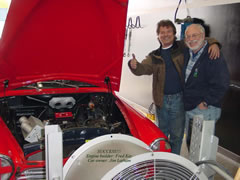
Jim got the opportunity to test the results on the Mission race track in June and it confirmed that the set up was basically correct although he had to richen up the SUs a bit more. He ended up going back to the UK needles and looking at the plugs determined that they too may be a little lean at full race, or that there may not be quite the fuel pressure needed (Jim uses the B30 mechanical fuel pump). Regardless, the car was very fast and Jim was very happy. Less happy were Gil in the 444 and Peter in his 544 as they will have their work cut out for them to keep up with Greta.
(p.s. I want to thank Brody Saari for answering all my questions. I was impressed with him and his company, Miller Performance Cars. You should see the custom performance package they have developed for the six cylinder BMW engine. Turbo, extra fuel injectors, refrigerated intercooler. Although Brody’s company specializes in BMW performance, they are able to tune most fuel injected cars that utilize engine management systems.
The dynamometer is available for rent, at $140 per hour with Brody at the helm. They also host club dyno-days at a rate per day where they do as many runs as time permit or for a smaller group a reduced fixed rate for an individual run such as $40 to see how your car really performs.
They can be reached at Miller Cars, 2001 Abbotsford Way, V2S 6Y5, 604-755-7692, email brody<at>millerperformancecars.com or view their website millerperformancecars.com.
